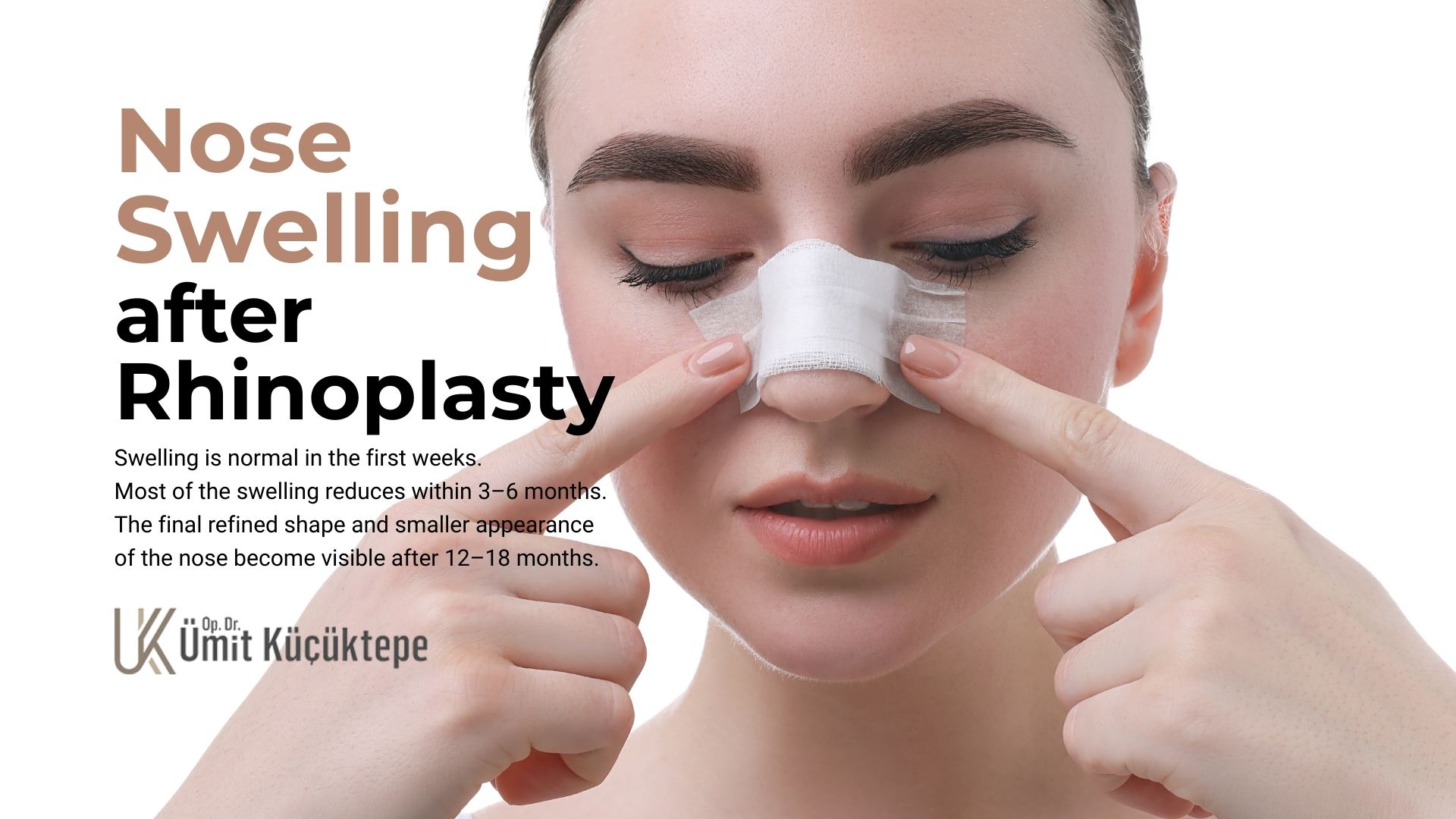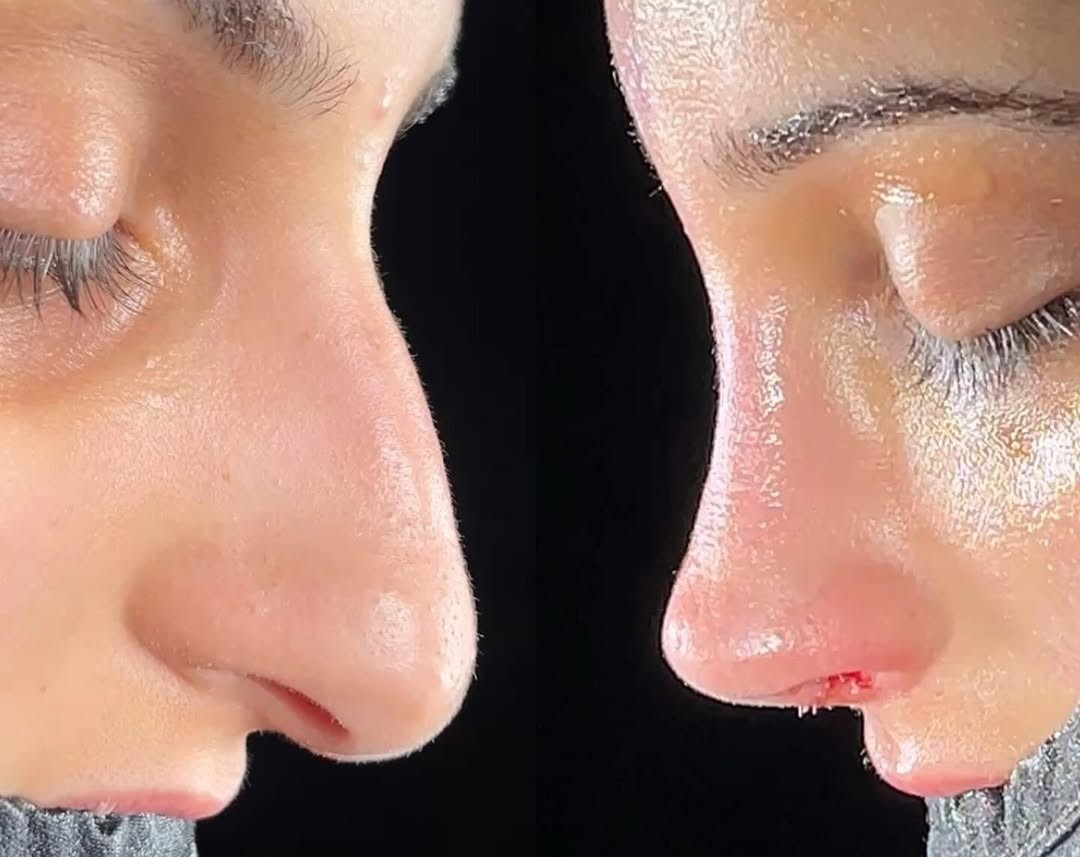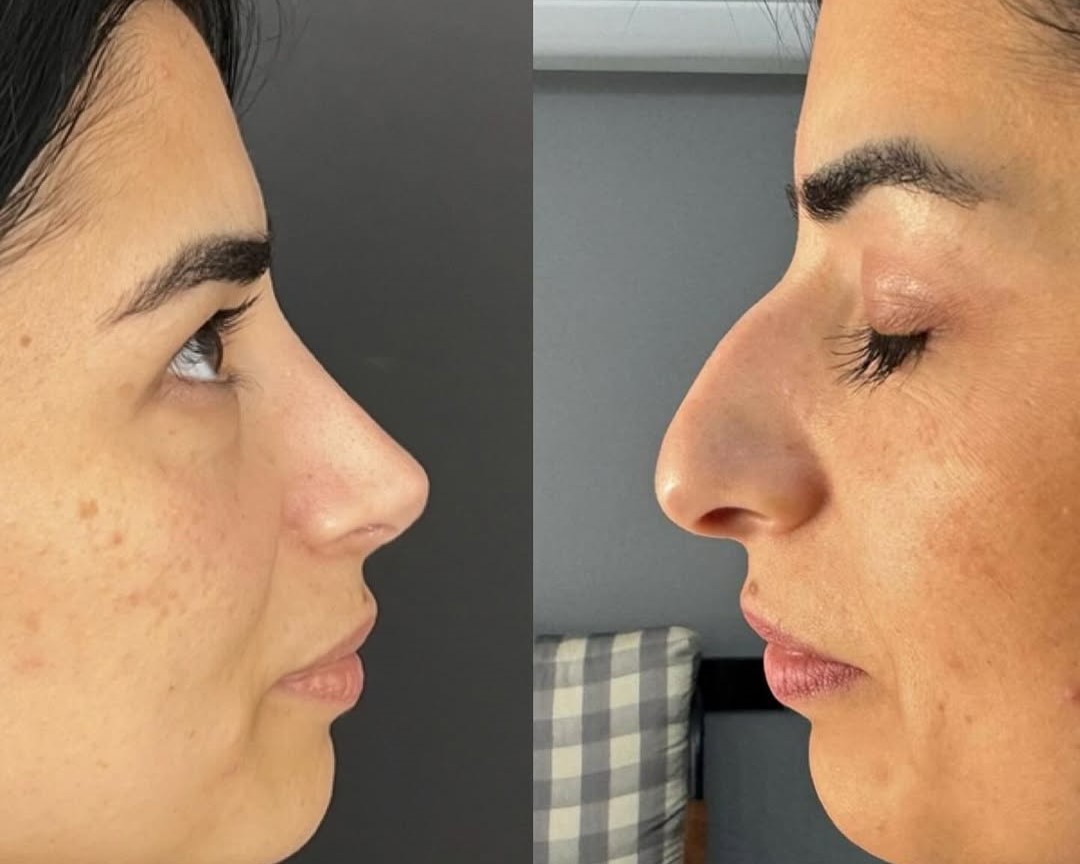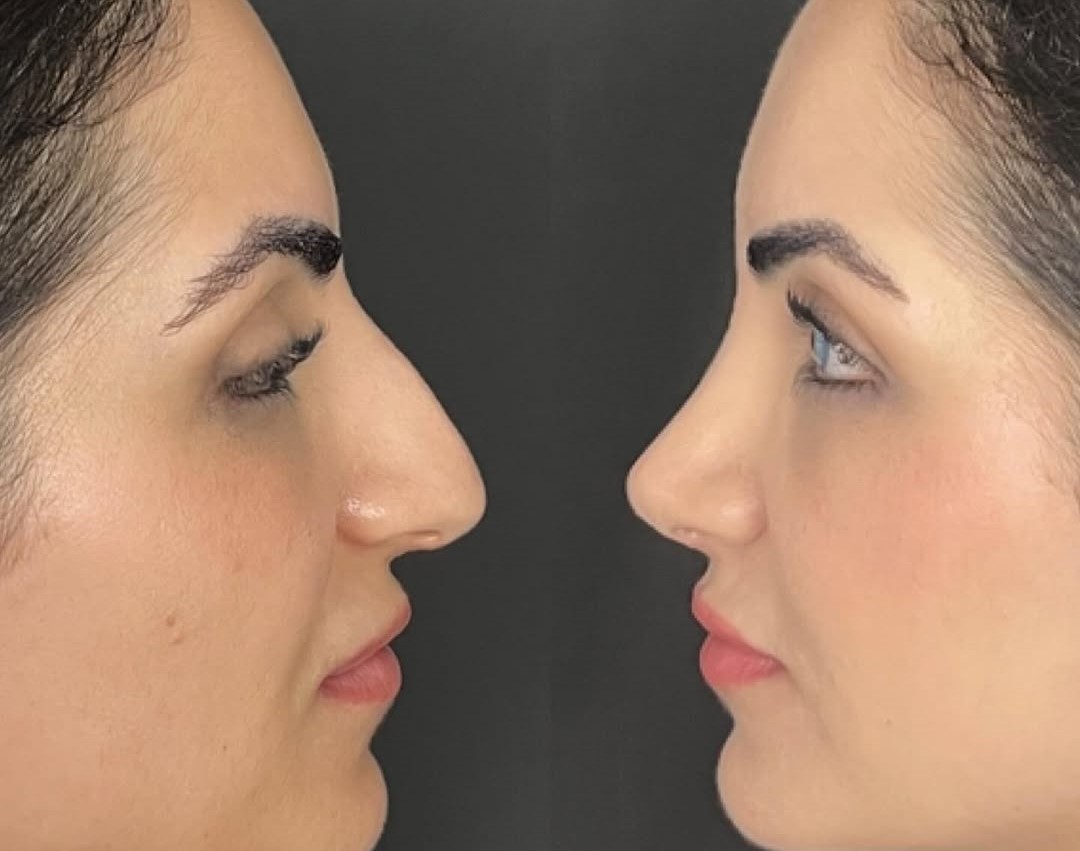Most of the swelling in the nose subsides within the first few weeks after rhinoplasty, but it may take 12-18 months for the minor swelling in the tip and wings to disappear.

Why does my nose look bigger after rhinoplasty?
Patients often feel that their nose is still large after rhinoplasty because the surgery was performed recently. The swelling in the nose has not yet subsided.
The general contours of the nose become apparent within 3-6 months after the surgery.
It may take 12-18 months for all the swelling in the nose to subside.
If your surgery was less than 18 months ago, your complaint is due to swelling in your nose.
How do I make my nose smaller again after rhinoplasty?
The time required for the swelling in the nose to subside may vary depending on the individual's genetics and the methods used by the surgeon. There are some things you can do in your daily life to speed up the swelling process.
For rapid reduction of the nose after rhinoplasty:
- Sleep with your head elevated: it is important to place pillows under your head, especially during the first few weeks.
- Apply cold compresses: applying cold compresses to the nose and face for the first 48 hours after rhinoplasty reduces swelling.
- Increase water intake: high fluid intake helps eliminate toxins from the body.
- Perform swelling-reducing massage: massaging the face and nose as recommended by your doctor helps reduce swelling.
- Smoking and alcohol should be avoided, or consumption should be reduced: smoking and alcohol slow down the healing process. It is important to avoid them during the healing period of the nose.
- Herbal tea should be consumed: herbal teas that help reduce swelling can be consumed.
- Collagen support should be taken: collagen production in the nose increases during the healing process. Collagen supplements can be taken to support this process.
How much does the nose shrink after rhinoplasty?

In rhinoplasty, reduction is not just about making the nose smaller — it's about achieving ideal proportions and harmony with the rest of the face. The extent of nasal reduction depends on the individual’s anatomy, skin thickness, and surgical goals.
Key factors influencing nasal reduction:
- Preoperative nasal size and shape
- Thickness and quality of the nasal skin
- Structural support for cartilage and bones
- Functional considerations (especially breathing)
On average, the nose may appear 10-30% smaller depending on the area being addressed — such as the tip, dorsum, or width of the nostrils. However, the goal is never excessive reduction but a natural, balanced result that fits the patient's facial structure.
Rhinoplasty is both science and art — every millimetre matters.
How to reduce swelling of nose after rhinoplasty?
Swelling in the nose after rhinoplasty is a normal part of the healing process. It may take 6-12 months for this swelling to subside. During this process, you can help reduce swelling by increasing fluid intake, limiting cigarette and alcohol consumption, and performing nose massages to support lymphatic drainage as recommended by your doctor.
If you still notice swelling and asymmetry in your nose 6-12 months after your rhinoplasty surgery, you may consider scheduling a follow-up examination with your surgeon.
What to eat after rhinoplasty surgery?
There are certain foods and food groups you can pay attention to in your diet to help reduce swelling in your face and nose after rhinoplasty and support the healing process.
- Pineapple: The bromelain it contains helps reduce swelling.
- Drinking plenty of water: Helps eliminate toxins from the body.
- Fresh fruits and vegetables: Supports the healing process.
- Protein-rich diet: Supports the healing process.
- Ginger and green tea consumption: Helps reduce swelling and supports the healing process.
- Antioxidant-rich foods: Consume red and pink-colored fruits and vegetables, such as watermelon, strawberries, and blackberries.
- Anti-inflammatory foods: Omega-3 sources (salmon, chia seeds, etc.).
What foods reduce swelling after rhinoplasty?
What food to avoid after rhinoplasty?
- Salty foods: Cause fluid retention.
- Packaged and processed foods: Do not support the healing process and may cause fluid retention.
- Alcohol and smoking: Delay healing.
- Refined sugar: May cause bloating and inflammation in the body.
How do I reduce my nose size without surgery?
It is not possible to reduce the size of a large nose without rhinoplasty surgery.
Nose filler can be applied to slightly lift the tip of the nose and soften the appearance of the nose bridge. However, filler treatment is only a temporary solution.
Does nose massage make it smaller?
If there is swelling across the entire face, massaging the face and nose can help the lymphatic drainage system, which may reduce the swelling. The swelling on the face may decrease.
Massaging the nose will not make it smaller. Surgery is required to reduce the size of the nose.
Can you reduce the size of your nose with surgery?
Yes, a large nose can be made smaller with rhinoplasty.
However, how much it can be reduced depends on the individual's nose structure, skin thickness, and the methods used by the surgeon. It is best to consult your surgeon for the most accurate prediction.
How to fix thick skin nose?
People with thick skin experience a reduction in the size of their nose after undergoing rhinoplasty.
Having thick skin can cause swelling in the nose to take longer to subside during the healing process. Thick-skinned noses may restrict aesthetic procedures.
Rhinoplasty in Thick Skin: A Unique Challenge
Thick nasal skin doesn't easily show fine details. That's why, in these cases, we focus on long-term structural support rather than aggressive reduction. Over time, the skin adapts to the new framework — results take longer, but with the right technique.
How long does it take for thick skin to shrink after rhinoplasty?
After rhinoplasty surgery on thick-skinned noses, it takes longer for the swelling in the nose to subside than it does for thin skin.
It is expected that the swelling in the nose will subside within 12-18 months.
Can rhinoplasty make the nose tip smaller?
In rhinoplasty surgery, the tip of the nose can be reduced at the patient's request and with the recommendation of an ENT specialist surgeon.
When will my nose tip get smaller after rhinoplasty?
The tip of the nose takes much longer to heal than other parts of the nose. It can take 6-12 months for the swelling in the tip of the nose to subside.
You can follow your doctor's recommendations to reduce the swelling in the tip of your nose.
Why are my nostrils different shapes after rhinoplasty?
It's completely normal for the nostrils to look slightly different from each other during the early healing period after rhinoplasty. Swelling, tissue stiffness, and healing differences between the two sides can all affect the appearance. As the swelling gradually decreases and the tissues soften, nostrils will settle into a more natural and balanced shape. This process takes time; final results are usually visible within 6 to 12 months. Patience is an essential part of this journey. In addition, the use of a nostril retainer during the recovery period positively contributes to the healing process.
When will the nostrils shrink after rhinoplasty?
Following rhinoplasty, the nostrils shrink depending on the procedure performed on them.
The nose regains its overall structure and symmetry within 6 months. Between 12 and 18 months, the aesthetic and small nostrils take their final shape.
What factors affect nose size after rhinoplasty?
- Genetic structure,
- The surgical procedure was performed,
- The patient adheres strictly to the post-operative instructions after undergoing rhinoplasty.
Do noses grow back after a nose job?
There is no growth associated with rhinoplasty after the procedure. Swelling during the postoperative recovery period may cause the nose to appear larger.
Minor changes may occur in the face and nose in general with advancing age.
Does the nose keep growing after rhinoplasty?
Immediately after rhinoplasty, nasal swelling is caused by oedema. Once the healing process is complete, the nose will shrink. The causes of oedema after rhinoplasty, and therefore nasal swelling, are:
- Trauma to the area during surgery,
- Disruption of the lymphatic drainage system and blood circulation system in the area during and after surgery,
- Fluid accumulation during the body's natural healing process,
- Factors related to the individual, such as insufficient use of cold compresses after surgery, incorrect sleeping position, excessive salt consumption, and consumption of processed and packaged foods.
Why does my nose look bigger after rhinoplasty?
The reason why the nose appears larger than desired immediately after rhinoplasty is due to swelling in the nose. The appearance of the nose in the first few weeks after rhinoplasty is not its final structure.
It is expected to take up to 12 months for the nose to achieve the desired aesthetic appearance.
When will my nose get smaller after rhinoplasty?
Most of the swelling in the nose subsides within the first few weeks after rhinoplasty. Macro swelling is drained by the sixth month.
Micro swelling may take 12-18 months to disappear from the body.
Month-by-Month change after rhinoplasty
During the first 48 hours, swelling in the nose reaches its peak. During the first week, there is noticeable swelling in the nose and under the eyes, and the nose appears large.
- During the first month, 70% of the swelling subsides, and the nose shrinks significantly.
- Between 3 and 6 months, 90% of the swelling in the nose subsides.
- Between 6 and 12 months, the swelling at the tip of the nose is expected to subside. The tip of the nose also shrinks.
- By the end of the month, the micro-swelling in the nose has subsided, the nose has shrunk, and it has reached its final shape.

For this patient, the outcome of the nose job after a year is satisfactory.


The other 1-year rhinoplasty results.

In rhinoplasty, long-term results matter the most.
While early changes can be seen within weeks or months, the true outcome of a rhinoplasty becomes fully apparent over time — often after 1 to 2 years, especially in patients with thick skin or complex nasal anatomy.
This patient is now in their third postoperative year, and what we see is a stable, refined, and natural result. Rhinoplasty success is based on how well the result ages, not just first impressions.
What happens if I exercise after rhinoplasty?
Strenuous exercise is not recommended for one month after rhinoplasty. Thereafter, light walking and sports can help reduce swelling and thus shrink the nose.
It would be healthier to consult your surgeon about different sports and workouts.
What medication is used to reduce swelling after rhinoplasty?
The use of creams (such as cortisol-containing creams) and medications recommended by your doctor is effective in reducing swelling.
Please contact Op. Dr. Ümit Küçüktepe for an examination and further information.
This article is for informational and advisory purposes. The recommendations of your surgeon, who will examine you and perform nose surgery, should be a priority.
